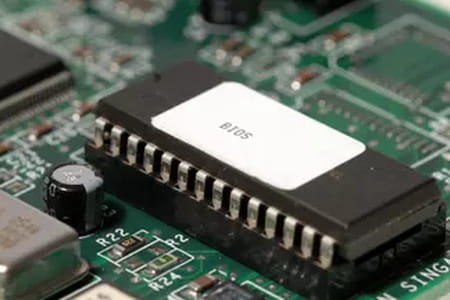The BIOS (like UEFI) manages all the electronic components of the PC, but also serves to lock access to them before launching Windows with a password. If you forgot it, you can reset the BIOS.
The BIOS is stored in a non-volatile memory chip housed on the motherboard. It does not go away even when the PC is turned off or unplugged. It is requested from the start of the PC, well, before Windows. In addition to managing all the electronic components of the computer, it also allows access to it to be locked with a password. To find out how to view the BIOS, read our How to Access PC BIOS or UEFI factsheet. If you forgot or lost it, then it is impossible to start the PC correctly and to have access to its contents. Don't panic, however. There are several methods to remove the password request on PC startup. It is thus possible to perform a hard reset (for desktop computers), remove the internal battery which maintains the energy required to supply the BIOS permanently or even perform a soft reset. Here are the steps to follow.
How to reset BIOS on stationary PCs?
To reset the BIOS so that it loses all traces of any passwords or to restore it to working order in the event of a crash, it is necessary to open the PC. You will then have to locate its location on the motherboard and move the jumper (also called jumper) placed next to it. The BIOS is generally located close to a button battery, easily identifiable. Caution: This procedure also resets other BIOS settings. If you have made any changes, they will have to be configured again.
- Open your computer case after turning it off completely and unplugging its power cable. Discharge static electricity by touching a metal part (radiator, tap, etc.).
- If possible, consult your motherboard documentation to locate the position of the jumper used to reset the BIOS. If you don't have any documentation, look on your motherboard for one of the following inscriptions: CLR BIOS, CLEAR BIOS, CLR CMOS, CLEAR CMOS, RESET BIOS ou RESET CMOS. It is usually located near the button cell battery on the motherboard. Note the name of the rider associated with the inscription. In our example, this is jumper JP4.

- Find the reset jumper on your motherboard. It is also usually near the battery. If the jumper is on a 3-pin connector, place it straddling the middle pin and the pin not initially covered (change from position pin1-pin2 to pin2-pin3, or vice versa). Wait a second then return the jumper to its original position (pin1-pin2).
- If the jumper is on a 2-pin connector and it covers only one pin, place it on both, wait a second, then return it to its original position.
- Reconnect the power cable to your box and start your PC: the password is gone.
How to reset BIOS by removing battery from motherboard?
Removing the coin-cell battery from the motherboard cuts off permanent power to the BIOS. As a result, the data it contains (settings and password) are erased.
- Disconnect the PC from the mains. Open the case and locate the battery on the motherboard.
- Remove the battery. Wait a few seconds, or press the PC power button for five seconds to empty the residual energy.

- Wait a few minutes then replace the battery. Reconnect and restart the PC.
- To learn more about the motherboard battery, see our fact sheet BIOS error: change the motherboard battery.
How to reset the BIOS of a PC with software?
On older PCs, if the password is only required to make settings in the BIOS, it is possible, with some motherboards, to recover it without having to perform all the operations described above.
Start by repatriating and installing the free utility CmosPwd.
Download CmosPwd for Windows
This program works with the following BIOS:
ACER / IBM BIOS
AMI BIOS
AMI WinBIOS 2.5
Award 4.5x/4.6x/6.0
Compaq (1992)
Compaq (New version)
IBM (PS/2, Activa, Thinkpad)
Packard Bell
Phoenix 1.00.09.AC0 (1994), a486 1.03, 1.04, 1.10 A03, 4.05 rev 1.02.943, 4.06 rev 1.13.1107
Phoenix 4 release 6 (User)
Gateway Solo - Phoenix 4.0 release 6
Toshiba
Zenith FRIEND
- CmosPwd works from the command line. Open the Windows Command Prompt (with the shortcut Win + R and type cmd). Then type the following commands and press Enter at each end of line.
Cd c:cmospwd-5.0windows
cmospwd_win /k
- You can then reset the BIOS (option 1) or reset it by trying to keep the date and time (option 2).
Contents Resetting the BIOS on stationary PCs Resetting the BIOS by removing the battery from the motherboard Resetting the BIOS of a PC with software The BIOS is stored in a non-volatile memory chip housed on the ...


























